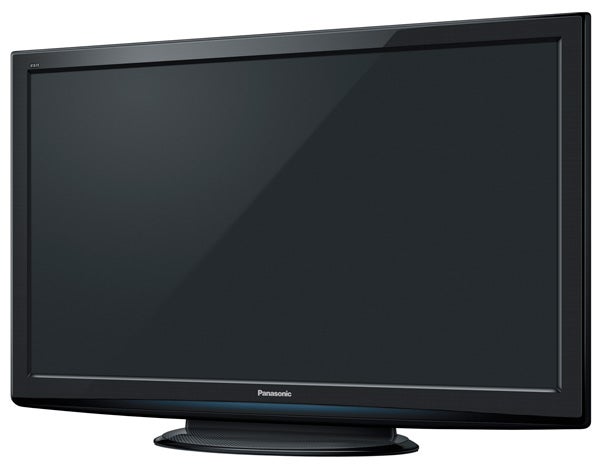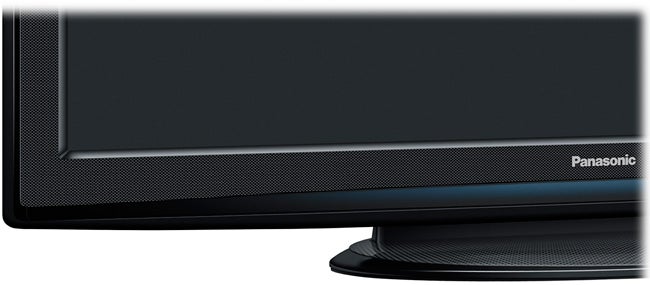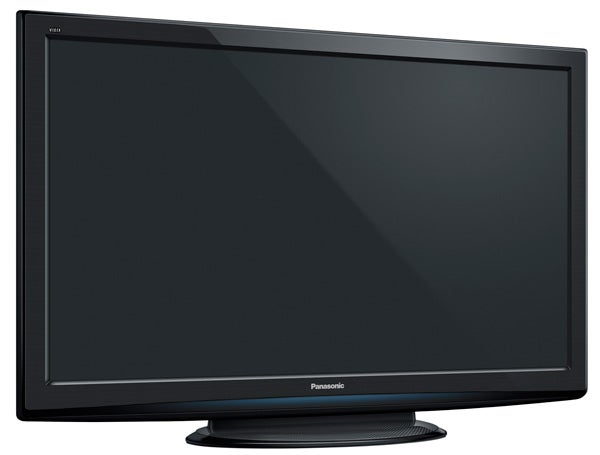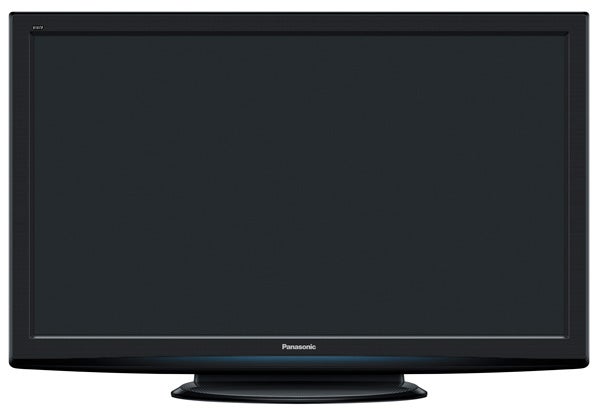Panasonic Viera TX-P50S20B 50in Plasma TV Review
Panasonic Viera TX-P50S20B 50in Plasma TV
Where high definition is concerned, the P50S20B is a likeable plasma TV.

Verdict
Key Specifications
- Review Price: £1050.00
A couple of weeks ago, I looked at and semi-liked the first set from Panasonic’s new plasma range, the TX-P37X20B. And during that review I commented that really the main thing the P37X20B did was whet my appetite for Panasonic’s upcoming G20 range, with its brand new NeoPDP technology.
Shame, then, that the 50in Panasonic TV I’m looking at today isn’t a G20 model either! However, before everyone gets too glum-faced, the P50S20B does at least move us a significant step closer to the G20 range than the entry-level P37X20B.
For starters, there’s the not insignificant fact that it sports a Freeview HD tuner – the first Panasonic TV to do so. In fact, it’s only the second Freeview HD TV I’ve seen from anyone (the first being Sony’s recently reviewed 40EX503).
Next, it sports 600Hz processing in place of the 100Hz system found on the X20 model. As ever, this 600Hz claim needs a little qualification, since the image doesn’t physically refresh 600 times a second, as you might expect. Instead, Panasonic derives the 600Hz figure from a processing engine that’s capable of adding enough extra ‘sub-fields’ to the picture stream. 
I get a lot of questions asking for more clarification about this issue, so I thought it might be a good idea in this review to spend more time than usual on the feature, and for the sake of clarity provide an explanation of the ‘600Hz Sub-Field Drive’ straight from the horse’s mouth (in this case Panasonic’s Canadian website, which gives a much more lucid explanation than the UK one!). So here goes:
”A standard video signal is actually a series of still images, flashed on screen so quickly that we believe we are watching a moving image. The typical frame rate used in North America is 60 frames per second (60Hz) meaning that a TV would display 60 individual still images every second. Sub-field drive is the method used to flash the individual image elements (dots) on a plasma panel. For each frame displayed on the TV the Sub-field drive flashes the dots 10 times or more, meaning that the dots are flashing 600 times per second (600Hz) or more. (Example: 60 frames per second x 10 sub-fields = 600 flashes per second).”
Or in the UK’s case, you get 50 frames per second x 12 sub-fields = 600 flashes per second.
To put all this in simpler terms, Panny’s 600Hz TVs retain a normal refresh rate, but activate the plasma pixels more rapidly to make the picture look smoother and more stable. So hopefully that’s finally got that one sorted out!
As with all 600Hz TVs, the P50S20B also carries Panasonic’s Intelligent Frame Creation technology for calculating new frames to sit between the existing ones coming in from a source. The purpose of this being, of course, to make motion look clearer and more fluid.
My heart also skipped a beat – for yes, I still get excited by new technology! – when I discovered that the P50S20B is actually a NeoPDP design. Last year’s S10 predecessor didn’t use Panasonic’s then brand-new NeoPDP technology, so it’s great to find it being brought further down the range this year.
However, my momentary surge of excitement quickly subsided, at least a little, when it turned out that the NeoPDP system in action here is actually last year’s version, not the potentially revolutionary new version coming in on Panasonic’s new models from the G20 up. Oh well. I guess this was probably inevitable given the P50S20B’s relatively affordable price tag.
The P50S20B’s, um, ‘old’ NeoPDP nature is not particularly obvious from its form factor. It’s much chunkier round the back than Panny’s flagship NeoPDP models, and the fascia initially looks like just another in Panasonic’s long line of uninspiring designs, with a simple black, trim-free, rather chunky rectangle sitting around the screen.
I said ‘initially’ back there, though, because on closer examination Panasonic has actually tried to do something a bit different for the S20 series. For the bezel is covered in what I can only describe as nobbles, giving it an unusual and actually quite pleasant tactile finish.
The problem with this little design touch, though, is that most normal people don’t spend as much time stroking their TV as they do watching it. Yet the nobbly effect is more or less invisible from any sensible viewing distance, unless sunlight happens to be spilling directly onto the TV’s front.
Turning to the P50S20B’s rear, it’s a bit disappointing to find that the P50S20B doesn’t really up the ante much from the X20 model when it comes to connections. There are still ‘only’ three HDMIs, for instance, and there’s still neither a D-Sub PC port nor a USB input. The only improvements come with an extra Ethernet port for accessing potential future Freeview HD interactive services (it doesn’t support Internet or DLNA PC access), and the ability of a built-in SD card slot to play DivX video on top of the AVCHD/JPEG support offered by the P37X20B.
There isn’t much going on in the P50S20B’s onscreen menus that we didn’t already see on the P37X20B either. And so your highlights chiefly comprise a small but adequate selection of picture presets (including Game and Cinema modes), a mostly avoidable Vivid Colour processor, optional noise reduction processing, and the reasonably likeable new Resolution Enhancer, for adding two optional levels of sharpness to pictures.
This delivers less pronounced results than JVC’s DynaPix HD engine, Philips’ Perfect Pixel HD engine, and Toshiba’s Resolution+. But in my opinion it still improves the look of standard definition at least a little without – if you only use the ‘Mid’ setting, at any rate – introducing distracting amounts of extra video noise.
The P50S20B’s pictures certainly improve over those of the P37X20B – as I’d expect given that it uses a NeoPDP panel rather than the P37X20B’s ‘standard’ one. However, the improvements aren’t significant enough to make the P50S20B truly exciting.
In fact, for me the most significant thing the introduction of last year’s NeoPDP engine brings to the P50S20B‘s party is more an issue of setup flexibility than raw picture quality. For the P50S20B offers much greater choice than non-NeoPDP screens between brightness and economy. In other words, the screen is capable of being driven more brightly than non-NeoPDP screens if you’ve got a lot of ambient light to contend with, or it can deliver more significant power-usage savings if you have a pretty dark room and so can get away with setting the screen’s brightness levels low.
The P50S20B’s raised brightness potential does help it deliver more vibrant colours, though – which is a welcome shift given the sometimes rather muted look of the P37X20B. What’s more, with HD the extra vibrancy gives at least the impression of a more dynamic and expansive colour range, complete with greater subtleties of shade.
It’s good to see, too, that the P50S20B’s greater colour dynamics are forged against the usual Panasonic plasma backdrop of rich, deep blacks no ordinary LCD TV can match (though good LED sets might give it a run for its money). Dark scenes also enjoy more shadow detail than we see with the average LCD TV, which has to reduce brightness in order to deliver a convincing black colour.
In fact, the P50S20B can look so much better with dark scenes than LCD rivals that this feature could be enough in itself to win any number of our movie-loving readers to its cause. Especially since, unlike most LCD TVs, the P50S20B doesn’t suffer loss of contrast or backlight inconsistency when viewed from even a very acute angle.
The 600Hz/Intelligent Frame Creation combination, meanwhile seems to work slightly more intelligently than I’ve seen it before, reducing judder in the image without introducing as many unwanted side effects (though there are occasionally still shimmering haloes around some moving objects).
Purists will likely still choose to leave the feature deactivated, and this is entirely understandable. But the feature now works well enough that I’d recommend that you at least experiment with it for a few minutes – with different source types – before deciding it’s definitely not for you.
I’d say that the P50S20B’s HD pictures look reasonably sharp, too. Not as meticulously crisp as some rival sets, perhaps, but enough to fully engage you in a definitively HD experience. I’d even say that some people might prefer the P50S20B’s ‘gentle’ approach to HD to really acute sharpness, since it tends to slightly reduce noise in the source signal to deliver a more even and thus potentially more involving image. If you’re the sort of person who can’t get enough of celluloid grain in your Blu-rays, though, then perhaps the P50S20B isn’t the best option.
Turning to why the P50S20B hasn’t bagged a Recommended badge, I was disappointed to find an unusually pronounced gulf between the screen’s handling of HD and standard def.
Standard def pictures look too soft, too noisy and most strangely of all, too oddly coloured to really satisfy. The first of these two problems are self-explanatory, and all I need to add is that no amount of toying with sharpness and noise reduction settings really solved my concerns.
The gulf in terms of colour accuracy/subtlety between the P50S20B’s actually quite excellent HD pictures and its SD ones is trickier to understand. All I can say is that the whole colour range seems to compress somehow with all but the most artificially shot ‘studio’ fare, leaving pictures looking less dynamic and less believable. Especially as some of the colour compression seems to be down sometimes to orange or green undertones that no amount of tinkering with the actually very limited colour adjustments managed to remove.
It’s notable, too, that the colour issues get progressively worse as the quality of your source material gets worse. Thank goodness this set has a Freeview HD tuner in it, giving you at least a couple of channels of HD broadcasts. Otherwise the only time you’d really be able to see this TV operating at its actually very good best would be when you watched a Blu-ray or Sky HD broadcast on it.
One further, much more minor picture issue is the occasional appearance of a little pixel ‘buzzing’ over skin tones if they happen to pass across the screen unusually quickly.
The P50S20B’s sound is interesting – and I don’t mean that necessarily as a euphemism for ‘rubbish’. For the speakers are unusually astute at picking out subtle background details. For instance, as Bond gets it on with the woman in the red dress in his hotel room in the Bahamas, the set manages to produce a sound of the sea in the background that I’ve only managed to detect with such clarity on a small handful of other TVs. And yes, I do realise that I am tragically probably the only person in the world who would be listening for background ocean sounds while there’s ‘sex stuff’ going on. Tragic.
The P50S20B‘s audio is also able to get quite loud without distorting, and has an open enough mid-range to both allow voices to remain clean and clear even during action sequences, and to open up at least a little to meet the demands of an action scene. The only problem is that if you push the speakers really hard, treble information can become rather harsh while bass feels rather ‘pseudo’ and strained. But it’s still a very respectable audio effort overall.
”’Verdict”’
The P50S20B is talented enough with HD material from Blu-ray, Sky or its own Freeview HD tuner to make it a likeable TV for a dedicated AV/home cinema room. But its potential as a main living room TV is hampered by its underwhelming standard definition performance. And I again have to say that nothing the P50S20B has done during this review has significantly reduced that now really irritating itch I have to get my hands on one of Panasonic’s G20 (or higher) models.

How we test televisions
We test every TV we review thoroughly over an extended period of time. We use industry standard tests to compare features properly. We’ll always tell you what we find. We never, ever, accept money to review a product.
Trusted Score
Score in detail
-
Features 8
-
Value 7
-
Image Quality 8
-
Design 7
-
Sound Quality 8
Features
| Size (Inch) | 50in |
| Display Type | Plasma |

